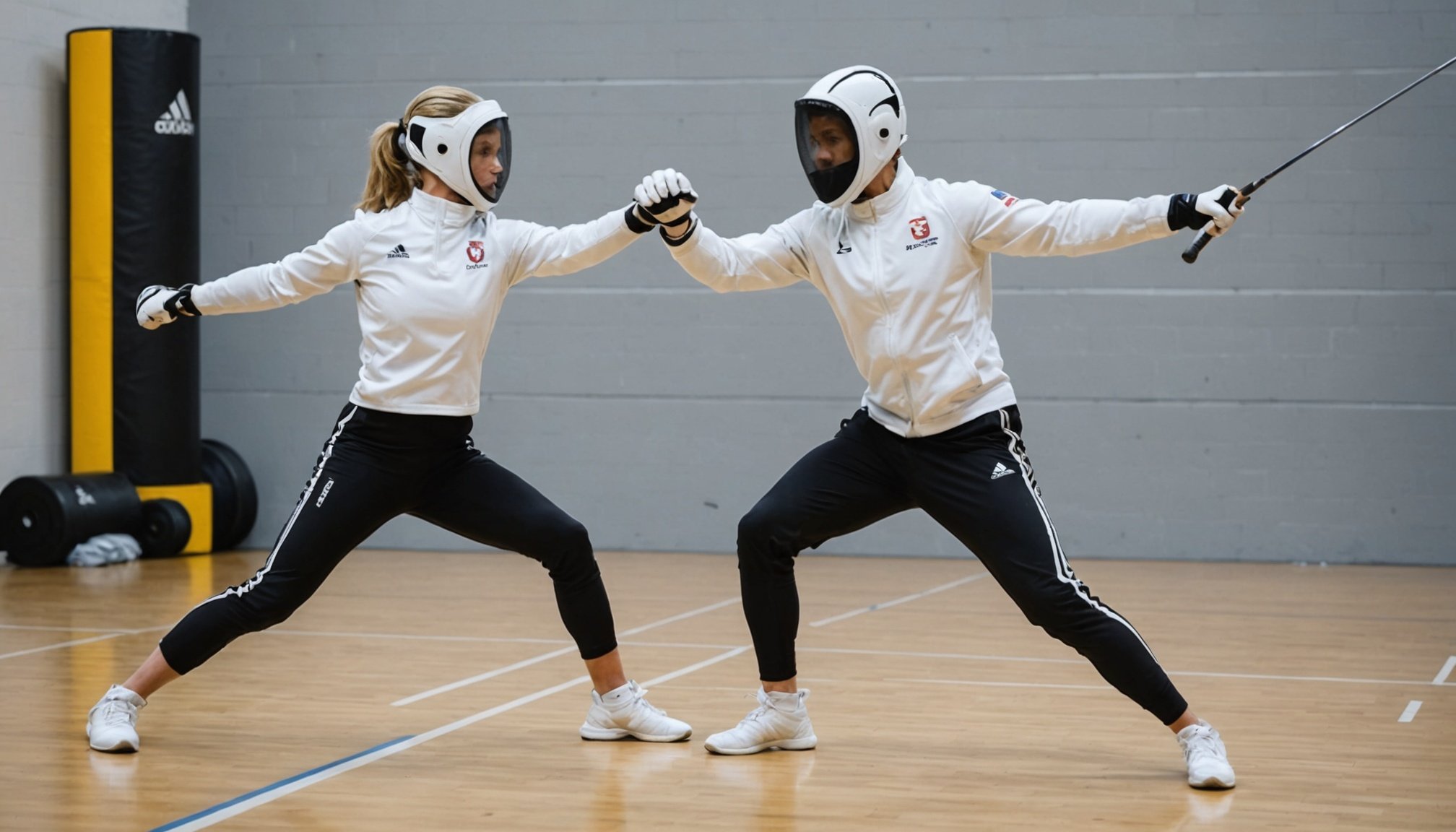Understanding the Fencing Lunge
The fencing lunge is a fundamental technique where agility and power converge to deliver effective offense. A successful lunge involves precise coordination of the limbs and core stability. The process begins with the back leg generating power, pushing the body forward while the front leg extends, facilitating rapid advancement toward the opponent. The upper body’s role is to maintain balance while staying aligned with the target.
Anatomy and Mechanics
UK athletes often focus on enhancing the biomechanics of their lunges, understanding that agility in the fencing lunge is paramount. The performance metrics commonly used to assess lunges include speed of initiation, distance covered, and recovery time. By prioritising these metrics, athletes can refine their technique, ensuring the lunge is both swift and controlled.
Also read : Unleashing your inner champion: the complete uk boxer”s handbook to speed bag mastery
Importance of Agility and Power
Agility is critical; it allows athletes to react and transition smoothly into a lunge. On the other hand, power is what transforms a lunge into a decisive strike. Optimising both elements is crucial for UK athletes looking to excel in competitions. By evaluating these performance metrics, they can tailor their training regimens to enhance and fine-tune their lunging technique over time.
Introduction to Dynamic Plyometric Training
Dynamic plyometric training is a specialised technique in the field of exercise science, aimed at enhancing an athlete’s explosive power and overall agility. This type of training involves rapid muscle contractions followed by an explosive release, typically through jumping exercises such as box jumps or squat jumps. These exercises leverage the stretch-shortening cycle that occurs in muscles and tendons, thus improving both muscular strength and endurance.
Benefits of dynamic plyometric training are particularly significant in sports like fencing, where speed and agility are crucial. For fencers, these exercises can lead to improved reaction times, quicker footwork, and more powerful lunges. By incorporating these workouts, athletes can develop the fast-twitch muscle fibres necessary for optimal performance.
The key principles of effective plyometric exercises include gradual progression in complexity and intensity, ensuring adequate rest between high-intensity bouts, and maintaining proper form throughout. Athletes should focus on exercises that mimic the movements and demands of their sport. This specificity ensures that training adaptations translate directly into better performance on the field or piste.
Essential Plyometric Exercises for Fencing
Plyometric exercises serve as a cornerstone in fencing training, enhancing speed and power. Focused on explosive strength, they amplify a fencer’s ability to lunge swiftly and with precision.
Box Jumps
Box jumps are instrumental for boosting leg power crucial in fencing lunges. To perform, stand in front of a sturdy box. Initiate a squat slightly, then leap powerfully using your legs to land on the box. Maintain light, controlled landings to protect joints. Integrating them into your routine enhances explosive leg strength. Start with a lower box, progressing to higher challenges to increase difficulty and develop agility. This gradual increase is key for effectiveness, ensuring the fencer develops both power and coordination safely.
Depth Jumps
Depth jumps refine reaction time and explosiveness critical in fencing. Start by stepping off a platform, landing softly, then immediately leap upwards upon contact with the ground. It’s vital to focus on quick ground contact time to maximise explosive power. Including depth jumps in training can significantly shorten your response time during bouts, making you a formidable opponent. It is advisable to incorporate these once a week to avoid overtraining and allow for muscle recovery.
Medicine Ball Throws
Medicine ball throws are versatile, fostering upper body strength essential for optimized lunge performance. Variations include overhead, chest, and rotational throws, each targeting different muscle groups. These exercises strengthen arm, shoulder, and core muscles, translating to more powerful lunges. Crafting a balanced routine with medicine ball throws complements leg-based plyometrics, fostering overall athleticism tailor-fit for a fencer’s dynamic needs.
Implementing Plyometric Training in Practice
Incorporating plyometric exercises into a training plan can significantly enhance athletic performance. Designing a schedule that effectively integrates these exercises requires careful consideration. For UK athletes, starting with two weekly sessions is optimal. This frequency allows adequate time for recovery, which is crucial in preventing overuse injuries.
A sample schedule might start with basic exercises like jump squats and progressively involve more complex movements such as depth jumps. It’s essential to tailor the volume of exercises to the athlete’s current level, typically starting with lower intensity and gradually increasing as the athlete adapts.
Implementation guidelines suggest each session should be no longer than 30-45 minutes. This time frame ensures effective training while minimizing the risk of fatigue, which can impede proper technique.
Progress monitoring plays a critical role in plyometric training. Tracking tools, such as performance journals or apps, can help athletes and coaches identify improvements. Key metrics to track include jump height, speed, and overall endurance. Regular assessments will support athletes in making data-driven adjustments to their training plans.
These strategies not only foster improvement but also empower athletes to make informed decisions about their training journey.
Testimonials and Case Studies
Hearing straight from athletes provides a clear picture of how plyometric training transforms performance. Let’s delve into some case studies from the UK that illustrate practical applications and athlete success.
UK Athletes and Improved Fencing Lunges
British athletes have been incorporating plyometric exercises to enhance their fencing lunges. By focusing on explosive power and agility, competitors have reported significant improvements in their reach and speed. These enhancements have translated into tangible successes in competitions, reflecting the practical applications of such training.
Specific Results Achieved
For instance, an elite fencer from London added plyometric workouts to her routine and observed a 20% increase in her lunge distance within three months. Another competitor reported reduced recovery time during matches, leading to improved endurance and higher placement in national tournaments.
Personalized Training Approaches
Athlete experiences highlight the importance of tailoring plyometric programs to individual needs for optimal results. Personalized regimens, based on initial assessments, allow athletes to focus on their unique weaknesses. Such a targeted approach ensures the exercises benefit each athlete’s specific goals, optimizing overall performance. In essence, these testimonials emphasize the versatility and efficacy of plyometric training in diverse athletic contexts.
















